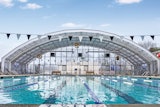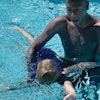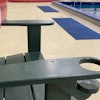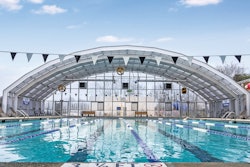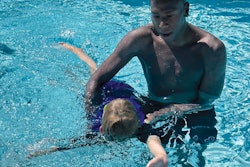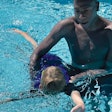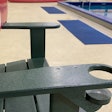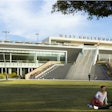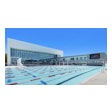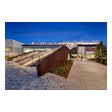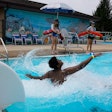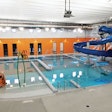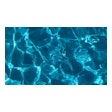This article first appeared on Inside Science. View the original here.
(Inside Science) -- Yet another new theory has surfaced that suggests the structure of the Olympic swimming pool may have given some swimmers advantages in Rio.
According to Timothy Wei, a professor of mechanical and materials engineering at the University of Nebraska-Lincoln, the strange swim time trends could have been caused by wave patterns created by the motion of the swimmers in the race. It's possible, he said, that some sort of interaction between the waves and the pool itself could have created the issue that multiple analysts have raised in reviewing the results from Rio.
On Wednesday, data analyst and former collegiate swimmer Barry Revzin posted an analysis on the website Swimswam.com showing some strange trends among the times posted by the swimmers.
In short, for swimmers traveling toward the finish line, the pool seemed to provide a roughly 1 percent performance boost to competitors in the higher number lanes of the eight-lane pool, and a similar reduction in performance in the lower numbered lanes. The effect was reversed when the swimmers turned around to travel the other direction.
Some U.S. researchers, including Indiana University physiologist and swim science expert Joel Stager, also documented the seeming lane bias. They suggested that a current in the pool might have helped the swimmers in high-number lanes log faster times during some competitions, the Wall Street Journalreported on Wednesday.
The issue is made clear by reviewing times from swimmers who moved from one side of the pool to the other for the preliminary heats, semifinals and finals, and also in the unexpected seesaw pattern of faster and slower lap times of many swimmers in the long distance events.
The effect was possibly most consequential in the 50-meter freestyle sprints, however, where the medals and even qualifying for the finals were determined by hundredths of a second. While there aren't a huge number of swimmers involved, experts find the evidence convincing that something affected the performance in the Rio pool, and that the size of the effect differed by lane.
"This is not random noise. This is a statistical reality. This is true," Stager said in an interview with Inside Science. "Fifteen of the 16 people making it out of the semis [in the men's 50-meter freestyle] came from lane 4 to 8. That's not supposed to happen."
Based on how swimmers performed in the preliminary heats and were assigned lanes in the semifinals, he said the semifinal races should have shown "a slight statistical advantage to coming out of [lanes 1 to 4] and not the other way around because they were seeded faster."
Stager also said that swimming officials have told him they noticed the strange lap times and tried to raise the issue.
Swim experts are flummoxed about why this happened, as is the company that designed the Rio pool, Myrtha Pools, according to their statements in the Wall Street Journal story and to Swimswam.com in a separate story released yesterday. They released videos of the pre-competition tests as well, which showed no current on the first and third days of Olympic competition.
Trevor Tiffany, Chairman of Myrtha Pools USA, was not available for immediate comment on Wei's wave theory.
According to Wei, his back of the envelope estimate suggests that the amount of water required to generate such a current produced by a pump would be too large for no one to notice it when the pool is empty. And Wei is no stranger to swimming. He's had a long time interest in it, and in 2008 and 2009 he worked with USA Swimming to study swimming performance.
Instead, he points to another way to move water in the pool: the motions of the swimmers themselves.
Swimmers obviously do move water. In fact, that's part of the reason why organizers began placing top swimmers in the middle lanes. Decades ago the outside lanes were much rougher than they are today before advancements in pool engineering such as gutters to take in the overwash along the side of the pool and wave-absorbing lane markers to reduce turbulence and other effects.
As engineering advances, those effects should be going away over time and not showing up in more pronounced ways such as at only certain elite swim meets including the Rio Olympics and the 2013 swimming world championships in Barcelona, Spain.
But those events have something interesting in common: Both took place in temporary pools, which are carefully engineered, but not as rigid as pools placed in the ground, which are used in many other venues, Wei said.
Here's what he thinks may have happened.
Wei said that when eight swimmers dive into the water almost simultaneously, it creates a big wave. That wave, then, could cause the pool itself to shake subtly, an effect which would be larger in a pool that is not encased in earth, and that would now interact with the pattern of waves produced by the swimmers throughout the race.
"You could end up with wave patterns where you get one phenomenon on one side of the pool, and you get another phenomenon on the other side of the pool," he said. "Now you've got swimmers that have to climb over waves on one side of the pool where you don't necessarily have to climb over waves on the other side of the pool."
The effect would continue throughout the race as the swimmers continue to move and create more waves, Wei said.
That would seem to square with the findings produced by Stager, who has published research in the journal Medicine & Science in Sports & Exercise about similar effects found in the 2013 swimming world championships, which took place in a temporary pool in Barcelona, Spain.
Stager's research has shown similar effects in multiple other championship pools, always in temporary setups. He said that FINA, the governing body for international swimming, should do more to ensure the fairness of the competition. "This is their responsibility," he said. "This is every bit or more important than wind speed [in track and field]."
FINA did not immediately respond to Inside Science's request for comment. [Editors' note: FINA sent an email shortly after publication stating that tests showed "that the competition was completely fair" and that FINA received no complaints about the conditions. They noted that "no current was detected in the Olympic Aquatics Stadium pool, at any stage of the competitions."]
Scott Hester, an engineer and the president of Counsilman-Hunsaker, a U.S. company that designs and builds pools for competition -- including those for the 1996 Olympics in Atlanta and the 2015 Pan American Games in Toronto -- remarked that developing a reliable testing protocol is difficult. There are even myriad variables outside the pool that can change between testing well before the event and the conditions at the height of competition. Those variables include, for example, the presence of thousands of spectators and changes in the environment produced by the arena's air conditioning system, he said.
"There's a lot more research that needs to be implemented to truly define what the situation is," said Hester.









